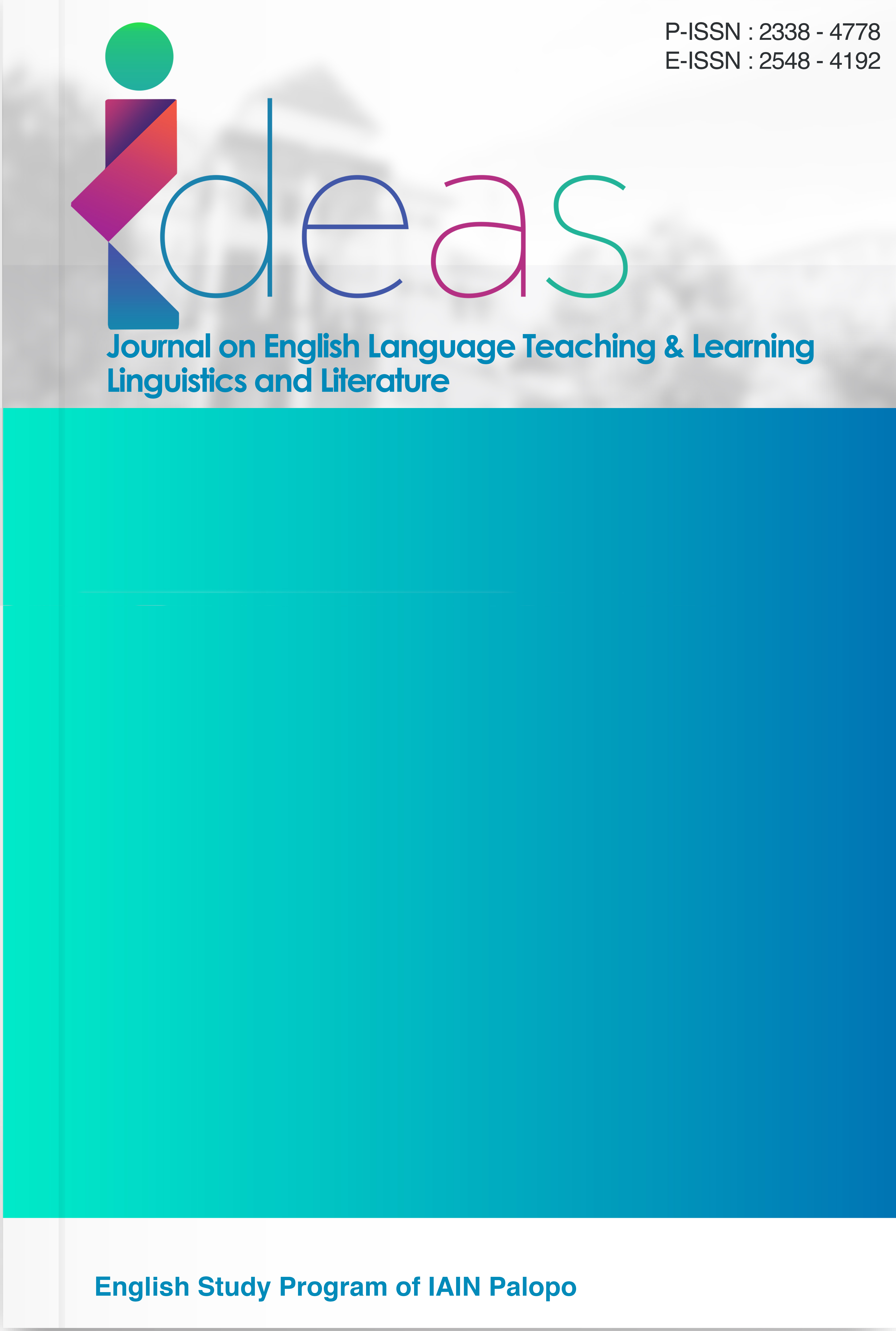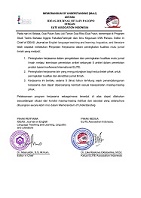Trend of Critical Discourses Analysis Researches in Linguistics Journals of Sinta 1 to 4: from CDA model to Research Design
DOI:
https://doi.org/10.24256/ideas.v13i2.6533Keywords:
linguistic journals, critical discourse analysis, data analysis, critical discourse analysis modelAbstract
The 21st century linguistic study aims to achieve various goals, and one of them is the empowerment of Critical Discourse Analysis as constructivist approach on linguistic study. This study utilized content analysis as a research method, specifically employing a document scanning approach. The articles selected for analysis were retrieved from the websites of Sinta1 to 4 in Indonesia between 2016 and 2022. To compile a list of journals indexed in the Sinta, the researchers accessed the Sinta and conducted a keyword search using "Linguistic" (Linguistic). Following these procedures, a total of 15 Indonesian linguistic journals were identified and analyzed a total of 30 articles . The objectiveof this research was to evaluate the range of Number of Publication, principles of CDA, CDAmodel, Type of Research, Type of Qualitative Data, Research Object, data collection and analysis techniques, as well as the research subjects covered in the articles published in. The findings of this study indicate an improvement in the number of publications on critical discourse analysis over the past three years. Qualitative research designs were dominant, particularly descriptive qualitative data. The most frequently targeted object of analysis was news scripts. Observations and content analysis were the commonly used instruments and dataanalysis methods. The Norman Fairclough Model and Culture were the discourse analysis model and principles of CDA employed in the research. Based on the research findings, severalrecommendations have been proposed for future studies that prioritize critical discourse analysis. These recommendations include enhancing the differentiation of research types, exploring alternative CDA models, focusing on analytical power in the study, and adopting more precise data analysis techniques.
References
Arbain, A. (2016). Critical Discourse Analysis of Eminem’s “Love the Way You Lie Part II.” Script Journal: Journal of Linguistics and English Teaching, 1(1), 1-10.
Byram, M. (1997). Teaching and Assessing Intercultural Communicative Competence.Multilingual Matters.
Cahyaningsih, O., & Pranoto, B. E. (2021). A CRITICAL DISCOURSE ANALYSIS: THE REPRESENTATION OF DONALD TRUMP IN REUTERS AND THE NEW YORK TIMES TOWARDS THE ISSUE OF #BLACKLIVESMATTER. Linguistics and Literature Journal, 2(2), 75-83.
Catalano, T., & Waugh, L. R. (2020). Critical discourse analysis, critical discourse studies, and beyond. Springer International Publishing
Fairclough, N. (1989). Language and Power. London: Longman.
Fairclough, N. (1995). Critical Discourse Analysis: The Critical Study of Language. London: Longman.
Fauzi, A., & Pradipta, R. (2018). Mapping Research Trends in Discourse Analysis: A Content Analysis of National Linguistic Journals. Journal of Applied Linguistics, 12(1), 45–57.
Fayruza, A. Z., Mahliatussikah, H., & Al Hayani, M. K. K. (2021). Critical Discourse Analysis of Teun A. Van Dijk's Model against Online News “The Decline in Refinery Profits Threatens to Increase Oil Prices.” Izdihar: Journal of Arabic Language Teaching, Linguistics, and Literature, 4(3), 275-290.
Fitts, S., Gross, L., & Ramirez, B. (2020). “We observed that the magnetic field is stronger than gravity”: Exploring linguistically diverse fourth-grade students’ written explanations in science notebooks. Linguistics and Education, 56, 100809.
Fajar, D. A. (2022). REPRESENTATION OF THE HYBRIDITY OF JAVANESE WOMEN
IN THE “TILIK” FILM. Premise: Journal of English Education and Applied Linguistics, 11(3), 545-560.
Hidayati, H., Zuindra, Z., Mayasari, M., Geubrina, M., & Arifuddin, A. (2018). THE POOR IN THOMAS GRAY'S ELEGY WRITTEN IN A COUNTRY CHURCHYARD: A CRITICAL DISCOURSE ANALYSIS APPROACH. Language Literacy: Journal of Linguistics, Literature, and Language Teaching, 2(2), 85-94.
Harwiyati, R., & Siagianto, B. E. (2016). Transitivity system in Joko Widodo’s speech at the APEC CEO Summit on November 10th, 2014, in Beijing, China. Premise: Journal of English Education and Applied Linguistics, 5(1), 160-171.
Insani, I., & Budiwati, T. R. (2021). Satanism as Reflected in Alan Walker’s Selected Song Lyrics. NOTION: Journal of Linguistics, Literature, and Culture, 3(1), 53-64.
Ibnus, N. (2019). The Representation of Reunion 212 in Indonesian Online Media. Journal of Linguistics, Literature, and Culture, 1(2), 68-75.
Khoirunisa, A., & Indah, R. N. (2017). Argumentative statements in the 2016 presidential debates of the US: A critical discourse analysis. JEELS (Journal of English Education and Linguistics Studies), 4(2), 155-173.
Liu, K., & Guo, F. (2016). A review on critical discourse analysis. Theory and Practice in Language Studies, 6(5), 1076.
Mills, S. (1997). Discourse. London: Routledge.
Masruddin, M., Amir, F., Langaji, A., & Rusdiansyah, R. (2023). Conceptualizing linguistic politeness in light of age. International Journal of Society, Culture & Language, 11(3), 41-55.
Najibulloh, Y., Komalawati, E., & Wilantara, M. (2022). Representation of Power and Ideology in Indonesian Political Discourse: A Critical Discourse Analysis Approach. Journal of Language and Politics, 21(2), 174–192. https://doi.org/10.1075/jlp.21002.naj
Pribadi, R. (2022). Kajian Kritis atas Diskursus Identitas dalam Iklan Digital: Pendekatan CDA dan Multimodalitas. Jurnal Linguistik Terapan, 5(1), 33–47.
Swastika, G. L. D., & Esther, J. (2020). Critical Discourse Analysis on Media Representation of Women: A Feminist CDA Perspective. Journal of Language and Gender Studies, 8(2), 112–126.
Van Dijk, T. A. (2008). Discourse and Power. Palgrave Macmillan.
Wodak, R., & Meyer, M. (2015). Methods of Critical Discourse Studies (3rd ed.). London: Sage.
Downloads
Published
Issue
Section
Citation Check
License
Copyright (c) 2025 Mutakhirani Mustafa, Nirwana, Nelly Husni Laely, Emi Anggreani Masjur, Eka Pitra

This work is licensed under a Creative Commons Attribution-ShareAlike 4.0 International License.
Authors retain copyright and grant the journal right of first publication with the work simultaneously licensed under an Attribution-ShareAlike 4.0 International (CC BY-SA 4.0) that allows others to share the work with an acknowledgement of the work's authorship and initial publication in this journal.
Authors are able to enter into separate, additional contractual arrangements for the non-exclusive distribution of the journal's published version of the work (e.g., post it to an institutional repository or publish it in a book), with an acknowledgement of its initial publication in this journal.
Authors are permitted and encouraged to post their work online (e.g., in institutional repositories or on their website) prior to and during the submission process, as it can lead to productive exchanges, as well as earlier and greater citation of published work (See the Effect of Open Access)




